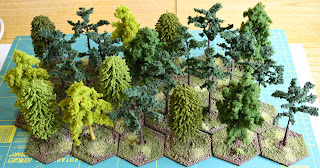The WW2 rules of choice at the moment are
Iron Ivan Games 'Disposable Heroes', an infantry and vehicle small unit skirmish game.
These rules are what I would term 'fast play' but with enough detail to add that level of 'realism' to make them that bit more interesting.
Primarily they are an infantry focused rule set. Vehicles when used should be there to
support the infantry units
not to charge around the battlefield and dominate it like the heroes from the Illiad.
The rules have some interesting abstract mechanics, such as infantry are not slowed down by terrain, so for example a squad running (which can move 9" in 28mm games) does not have to deduct an inch here for jumping a wall, 2" there for entering a building. This may go against the norm for miniature wargames, but terrain does then effect line of sight, and firing at a target over linear obstacles attracts a penalty. Of course with particular terrain features such as a marsh then players can impose their own movement penalties if you wish.
Turns are initiative based, with one player moving a unit then his opponent, then the first player and so on. Each activated unit can move and fire or fire and move. With firing another abstraction is that only a half a squad (section) may fire. This is to represent the 'confusion' of combat i.e. team members may be reloading, observing etc and so do not engage the enemy. This was one rule which I personally had a issue with, to use to rules in which everything can 'blaze away', but having played a few games, I now quite like it.
Morale is important in this game, with units having to take a morale check (referred to as a Guts check), even when fired on and no casualties caused. This system throws in a level of uncertainty, and generally does not cause that much of a problem (unless its me throwing the dice, and I have my appalling run of bad luck).
Vehicles are not the metal monsters of some games, but still have to be accounted for, but they should be protected by infantry in order to be truly effective. The rule writers have tempered vehicles (i.e. tanks) by requiring them to make an acquisition roll to spot a target. This effectively stops AFV's charging round the games table, blasting everything in sight. A frustrating rule but again one I like, and it must be remembered this a
small unit game. It is not designed to represent the armour clash at
Prokhorovka. The designers recommend if you want to play armour battles remove the acquisition rule.
Indirect fire, like vehicles, is not that effective ((generally) though have only used on table mortars in games so far) but is there more to annoy your opponent and give them something to think about. These rules do place emphasis on movement and not staying static. To do so attracts unwanted attention which may find your units suffering morale checks and the battle plan going awry.
Using cover effectively, reduces the impact of fire combat (but remember morale), yet if hits are scored then 'kills' are pretty much guaranteed.
The rules are supported by excellent supplements for the main combatants (designed for mid to late war games), and though the lists contained within the supplements are points based, it's not necessary to play these rules and be a slave to an army list. Supplements also exist for Early War and the War in the Pacific, neither of which I have but will probably be purchasing.
Have played a few games recently and 'after actions reports can be found here
wargamesbutterfly and here
wargamesbutterfly. Posted by the dashing Mr R, who at the moment leads to 2 to 1 on the victory counter.
Wargames rules come and go and WW2 rules in particular seem to be easy victims to the fickle nature of gamers. At the moment for me these rules score an 8.5 out of 10 (theres always something which an individual does not agree with ) and personally I would like to keep as rules of choice for a while. As an indication prior to this had be playing the
Rules of Engagement set from Great Escape Games. These borrowed heavily from the GW style of games ( I believe the designers are ex-GW staff?). Though comprehensive rules I found them at time 'clunky' and time consuming and score them a 5 out of 10 for playability. So give DHC7B ago, see what you think.




































